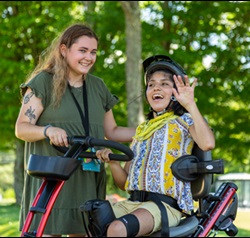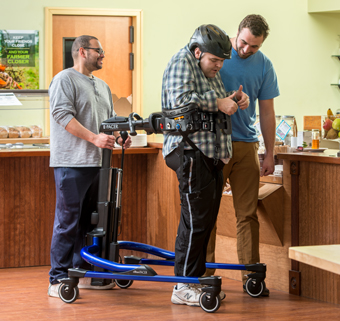The ICF Framework, F-words, and People with Developmental Disabilities
| October 2025
The International Classification of Functioning, Disability, and Health (ICF) has been developed by the World Health Organization (WHO) as a comprehensive framework in which to classify the varying aspects of a person’s health condition and disability.1 With the ICF model, the focus is turned towards achieving the best possible activity and participation level in society despite the disability.
Endorsed by the American Physical Therapy Association (APTA) and the American Occupational Therapy Association (AOTA), the ICF framework continues in world-wide expansion and acceptance, being integrated in the treatment approaches of healthcare workers serving individuals with disabilities.
Earlier systems, like the ICD-10, emphasized causes and limitations of disability. In contrast, the ICF mainstreams the lived experience of disability, recognizing that every person may face a health challenge at some point.
The Structure of the ICF Framework
The ICF categories are organized into an assessment tool that describes health and disability on three levels, known as the ICF components:
- Body functions and structures
- Activities and participation
- Environmental factors
This ICF assessment can be used to measure interventions, identify barriers to participation, and develop plans to overcome them. Healthcare professionals also rely on ICF core sets, which group relevant ICF codes to streamline evaluations for specific conditions.
From Prior Models to the Current ICF Biopsychosocial Model
To understand the application of the ICF, it’s helpful to review the two earlier approaches to disability:
- The Medical Model: Disability is an inherent part of the individual, caused by disease, and treated through medical intervention.
- The Social Model: Disability arises from environmental barriers and social attitudes, not just the body.
Each model on its own is incomplete. When combined, they form the ICF biopsychosocial model, the foundation of the ICF. This combined approach highlights that disability is not only about body impairment. It also emphasizes the importance of activities, participation, and the environment—broadening interventions and treatment planning.
Application of the ICF in Clinical Practice
With the ICF framework, therapy is no longer just about body parts—it’s about the whole person. For people with developmental disabilities, this means:
- Interventions that target body functions and structures
- Plans that promote activities and participation in schools, workplaces, and communities
- Support for removing environmental barriers that limit independence
When barriers to participation are reduced, disability itself diminishes. This approach makes the ICF far more function-oriented and activity-based compared to the medical model alone.
A Global Shift in Healthcare
With the adoption of the ICF model, healthcare around the world is being redefined. Therapists and other professionals are empowered to:
- Use standardized ICF codes and ICF categories to document functioning
- Apply ICF core sets for efficient assessment
- Expand interventions beyond the clinic to the environment where participation happens
For individuals with developmental disabilities, this shift is both exciting and hopeful. By embracing the classification of functioning, disability, and health, the ICF helps ensure that therapy and interventions are not just about treatment, but about enabling full participation in life.
The “F-words”

For the pediatric population, CanChild researchers Peter Rosenbaum and Jan Willem Gorter launched the “F-words” in childhood disability.2 Based on the ICF, the “F-words” offer a child- and family-friendly framework for childhood disability.
These six empowering “F-words” for Child Development—Function, Family, Fitness, Fun, Friends, and Future—encourage clinicians, educators, and families to look at the “whole child,” celebrating what children can do rather than dwelling on their limitations. The purpose is to shift focus from deficits and impairments toward strengths and the developmental areas that truly matter for a fulfilling life.
Each “F-word” corresponds to a core ICF component. The framework provides a common language that emphasizes participation, well-being, and growth across all domains of childhood.
Connecting the F-words to the ICF
- Fitness relates to Body Functions and Structures, addressing physical and mental well-being. The team examines strengths and abilities, including capacity for physical activity and any challenges or successes.
- Function corresponds to Activity, focusing on completing tasks regardless of how they are accomplished. This emphasizes practice and support for daily activities, considering what the child can do, noting improvements and targeting skill areas within the child’s routines.
- Friends is tied to Participation, recognizing the importance of social engagement in real-life contexts. This domain highlights opportunities to strengthen social connections.
The remaining F-words complete the ICF's contextual picture.
- Family represents Environmental Factors, acknowledging the home and support network as essential to a child’s development, stressing the importance of family-centered service. Family dynamics that may potentially impact progress are considered, and resources are incorporated.
- Fun aligns with Personal Factors, recognizing that unique interests benefit development. Enjoyable activities motivate learning and are integrated into education and therapy strategies.
Finally, Future is an essential addition for pediatric care. The F-words framework moves beyond the ICF’s snapshot of current status that describes the person today. Through including the term Future we’re reminded that children are a “work in progress” and that their day-to-day activity has an impact on their future. Children are ever-changing due to their growth and development and the goals we set today can target future outcomes.
The F-words framework helps children and families achieve their hopes and aspirations across the lifespan. By linking the F-words to the ICF domains, the F-words serve as a practical, actionable translation of the ICF, ensuring that interventions and research aim for holistic development and inclusion. 3 4
To learn more about the ICF go to: https://www.who.int/classifications/icf/en/
To learn more about the “F-words” go to: https://canchild.ca/research-in-practice/f-words-in-childhood-disability/
1. World Health Organization. International Classification of Functioning, Disability, and Health (ICF). Available at: https://www.who.int/classifications/international-classification-of-functioning-disability-and-health. Accessed October 10, 2025.
2. Rosenbaum PL. The F-words for child development: functioning, family, fitness, fun, friends, and future. Dev Med Child Neurol. 2022;64(2):141-142. doi:10.1111/dmcn.15021
3. De Campos AC, Hidalgo-Robles Á, Longo E, Shrader C, Paleg G. F-words and early intervention ingredients for non-ambulant children with cerebral palsy: A scoping review. Dev Med Child Neurol. 2024;66(1):41-51. doi:10.1111/dmcn.15682
4. Leite HR, de Sousa Junior RR, Souto DO, et al. F-words ingredients of non-invasive interventions for young ambulant children with cerebral palsy: A scoping review. Dev Med Child Neurol. 2025;67(2):150-164. doi:10.1111/dmcn.16074




